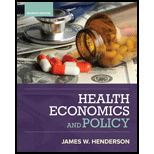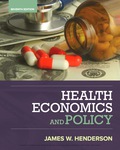
The significance of the downfall of a social system in contributing to a crisis of healthcare spending.
Explanation of Solution
Obesity is considered one of the major social issues faced by the United States of America. It is even seen as a national epidemic. Over the past fifty years, the figures of obesity have risen drastically. More than one third of the adults in the United States have been clinically declared as obese. The medical cost of an obese individual has been calculated as $1429 more than a healthy individual. 9.1% of the total medical spending in the country accounts for obesity related matters. Further, the use of alcohol and drugs has also been much instrumental in increasing the medical care spending figures. Individuals that consume alcohol and use drugs commit various illnesses in the long run. In treating such diseases, a huge cost must be borne by the country. Nevertheless, as a result of various individuals consuming alcohol and drugs, there may be other parties affected. For example, a parent consuming alcohol may abuse his or her children either physically or mentally. Treating such affected partied would also add up to the total medical spending. Teen pregnancy has also been instrumental in fueling up the healthcare spending figures. A majority of teen mothers have been identified as heavy smokers. This creates negative impacts upon the health of the mother as well as the baby. Domestic violence, another contributor to increased healthcare spending, does it in two ways. Bodily injuries caused by incidents of domestic violence and the mental trauma suffered by victims must be treated accordingly. All the factors aforesaid show the deterioration of values within society which directly and indirectly contribute to a rising cost of medical care that must be borne by a society.
Introduction:
Within the current context, one could identify a number of social problems that create a great impact upon the amounts spent on health care. Their impact has become so intense that one could in fact consider them as health issues faced by a society. Obesity, the use of alcohol and drugs, teen pregnancy and domestic violence are some examples for such social problems. These problems depict the downfall of a society and lead the society to a crisis situation where enormous amounts must be spent in relation to the healthcare of affected parties.
Want to see more full solutions like this?
Chapter 6 Solutions
Health Economics and Policy
- How is the mining industry related to other Canadian labour industries? Choose one other industry, (I chose Forestry)and describe how it is related to the mining industry. How do the two industries work together? Do they ever conflict, or do they work well together?arrow_forwardWhat is the primary, secondary, tertiary, and quaternary levels of mining in Canada For each level, describe what types of careers are the most common, and describe what stage your industry’s main resource is in during that stagearrow_forwardHow does the mining industry in canada contribute to the Canadian economy? Describe why your industry is so important to the Canadian economy What would happen if your industry disappeared, or suffered significant layoffs?arrow_forward
- What is already being done to make mining in canada more sustainable? What efforts are being made in order to make mining more sustainable?arrow_forwardWhat are the environmental challenges the canadian mining industry face? Discuss current challenges that mining faces with regard to the environmentarrow_forwardWhat sustainability efforts have been put forth in the mining industry in canada Are your industry’s resources renewable or non-renewable? How do you know? Describe your industry’s reclamation processarrow_forward
- How does oligopolies practice non-price competition in South Africa?arrow_forwardWhat are the advantages and disadvantages of oligopolies on the consumers, businesses and the economy as a whole?arrow_forward1. After the reopening of borders with mainland China following the COVID-19 lockdown, residents living near the border now have the option to shop for food on either side. In Hong Kong, the cost of food is at its listed price, while across the border in mainland China, the price is only half that of Hong Kong's. A recent report indicates a decline in food sales in Hong Kong post-reopening. ** Diagrams need not be to scale; Focus on accurately representing the relevant concepts and relationships rather than the exact proportions. (a) Using a diagram, explain why Hong Kong's food sales might have dropped after the border reopening. Assume that consumers are indifferent between purchasing food in Hong Kong or mainland China, and therefore, their indifference curves have a slope of one like below. Additionally, consider that there are no transport costs and the daily food budget for consumers is identical whether they shop in Hong Kong or mainland China. I 3. 14 (b) In response to the…arrow_forward
- 2. Health Food Company is a well-known global brand that specializes in healthy and organic food products. One of their main products is organic chicken, which they source from small farmers in the area. Health Food Company is the sole buyer of organic chicken in the market. (a) In the context of the organic chicken industry, what type of market structure is Health Food Company operating in? (b) Using a diagram, explain how the identified market structure affects the input pricing and output decisions of Health Food Company. Specifically, include the relevant curves and any key points such as the profit-maximizing price and quantity. () (c) How can encouraging small chicken farmers to form bargaining associations help improve their trade terms? Explain how this works by drawing on the graph in answer (b) to illustrate your answer.arrow_forward2. Suppose that a farmer has two ways to produce his crop. He can use a low-polluting technology with the marginal cost curve MCL or a high polluting technology with the marginal cost curve MCH. If the farmer uses the high-polluting technology, for each unit of quantity produced, one unit of pollution is also produced. Pollution causes pollution damages that are valued at $E per unit. The good produced can be sold in the market for $P per unit. P 1 MCH 0 Q₁ MCL Q2 E a. b. C. If there are no restrictions on the firm's choices, which technology will the farmer use and what quantity will he produce? Explain, referring to the area identified in the figure Given your response in part a, is it socially efficient for there to be no restriction on production? Explain, referring to the area identified in the figure If the government restricts production to Q1, what technology would the farmer choose? Would a socially efficient outcome be achieved? Explain, referring to the area identified in…arrow_forwardI need help in seeing how these are the answers. If you could please write down your steps so I can see how it's done please.arrow_forward

 Exploring EconomicsEconomicsISBN:9781544336329Author:Robert L. SextonPublisher:SAGE Publications, Inc
Exploring EconomicsEconomicsISBN:9781544336329Author:Robert L. SextonPublisher:SAGE Publications, Inc


 Microeconomics: Private and Public Choice (MindTa...EconomicsISBN:9781305506893Author:James D. Gwartney, Richard L. Stroup, Russell S. Sobel, David A. MacphersonPublisher:Cengage Learning
Microeconomics: Private and Public Choice (MindTa...EconomicsISBN:9781305506893Author:James D. Gwartney, Richard L. Stroup, Russell S. Sobel, David A. MacphersonPublisher:Cengage Learning





